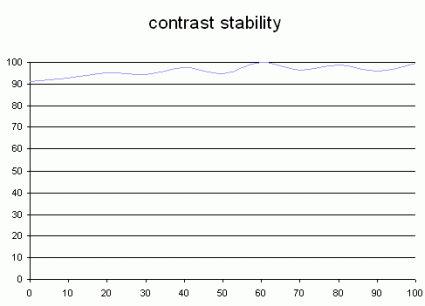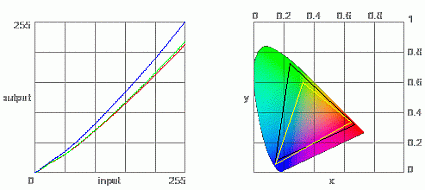A Revolution? The First Lumileds LCD Display
NEC SpectraView 2180WG-LED: Ultra-High Fidelity, Continued
Naturally, the stability of the contrast was remarkable. It may look a bit low here, but don't forget that the contrast ratio doesn't have much to do with color dynamics, and though the 2180WG-LED's contrast is low, its color dynamics aren't.
This curve indicates the contrast value measured at a given brightness adjustment level on the OSD. In theory, brightness and contrast are two independent parameters, and good contrast is a requirement regardless of the brightness adjustment. Unfortunately such is not the case in practice.
The brightness adjustment is shown on the X-axis, contrast on the Y-axis. Contrast is expressed here as a percentage of the maximum value measured using the ANSI test protocol.
Tested with the Gretag Eye-One Display 2, the SpectraView 2180WG-LED showed a little more of what it can do. By the way, the "WG" in 2180WG-LED stands for Wide Gamut, and now we know why.
The yellow line represents the color gamut of the Eizo L997, currently the best LCD display in terms of color rendering. The black line shows the gamut of the SpectraView 2180WG-LED. Its superiority is overwhelming. The SpectraView 2180WG-LED covers more colors in the reds and greens, and it's just as good for blues. In fact, the SpectraView 2180WG-LED is one of the rare monitors that can claim to fully cover the Adobe RGB color space, which is much more demanding than the traditional sRGB.
Get Tom's Hardware's best news and in-depth reviews, straight to your inbox.
Current page: NEC SpectraView 2180WG-LED: Ultra-High Fidelity, Continued
Prev Page NEC SpectraView 2180WG-LED: Ultra-High Fidelity Next Page Spatial Uniformity
